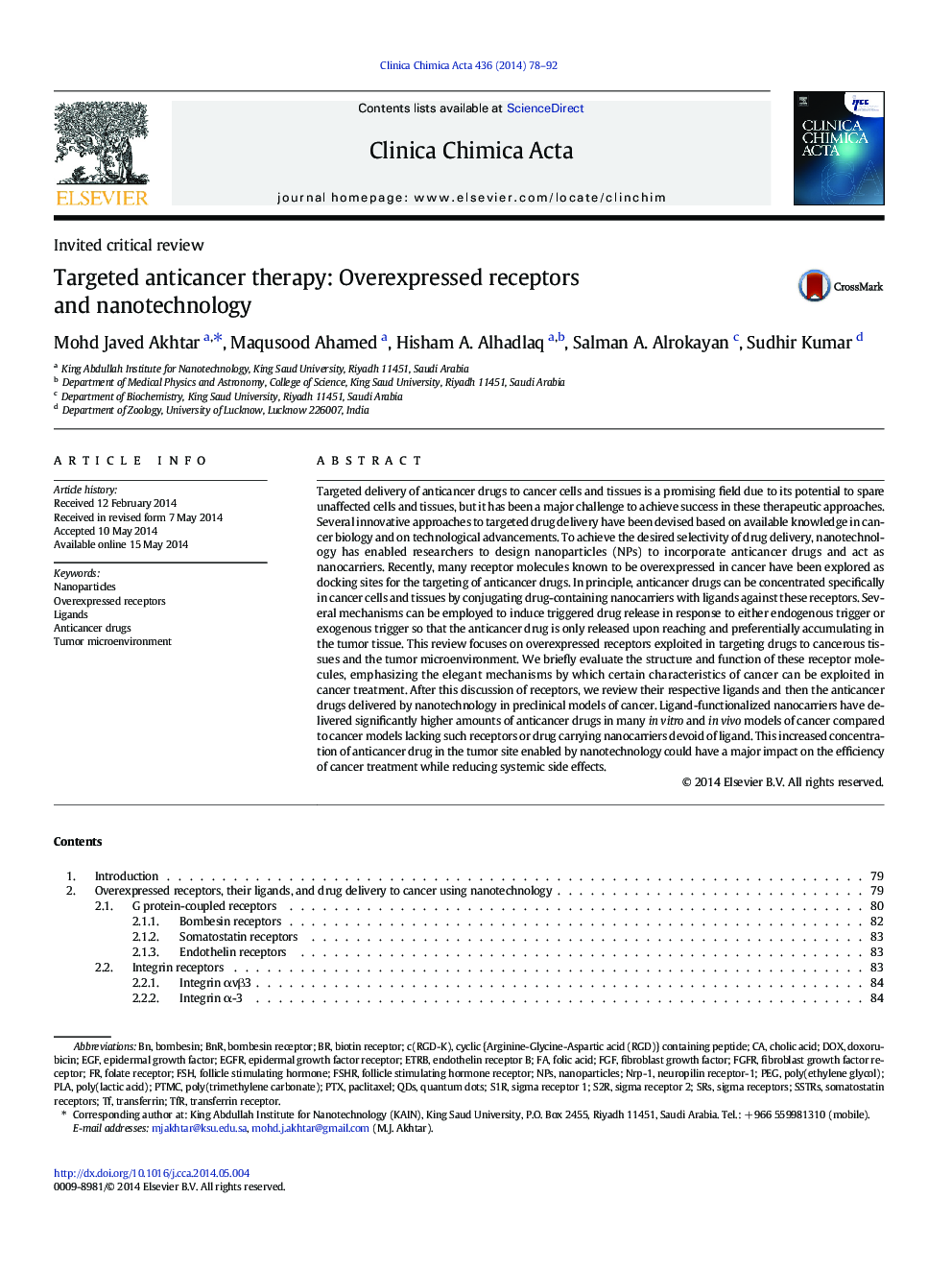| کد مقاله | کد نشریه | سال انتشار | مقاله انگلیسی | نسخه تمام متن |
|---|---|---|---|---|
| 8311433 | 1538662 | 2014 | 15 صفحه PDF | دانلود رایگان |
عنوان انگلیسی مقاله ISI
Targeted anticancer therapy: Overexpressed receptors and nanotechnology
ترجمه فارسی عنوان
درمان ضد سرطان هدفمند: گیرنده های بیش از حد بیان و فناوری نانو
دانلود مقاله + سفارش ترجمه
دانلود مقاله ISI انگلیسی
رایگان برای ایرانیان
کلمات کلیدی
QDsETRBPTMCSSTRsS1RBNRNRP-1FSHRFGFRPTXSRSFGFPLATransferrinEGFRTFREGFDOXNPs - NP هاFolic acid - اسید فولیکCholic acid - اسید چلیکBombesin - بمبسینAnticancer drugs - داروهای ضد سرطانDoxorubicin - دوکسوروبیسینepidermal growth factor - عامل رشد اپیدرمیfibroblast growth factor - فاکتور رشد فیبروبلاستLigands - لیگاندهاTumor microenvironment - میکرو محیط زیست تومورNanoparticles - نانوذراتquantum dots - نقاط کوانتومیfollicle stimulating hormone - هورمون تحریک کننده فولیکولFSH - هورمون محرکه فولیکولی Paclitaxel - پاکلی تاکسلPoly(trimethylene carbonate) - پلی (تریتییلن کربنات)Poly(lactic acid) - پلی (لاکتیک اسید) Poly(ethylene glycol) - پلی اتیلن گلایکول PEG - پلیاتیلن گلیکول Folate receptor - گیرنده Folatetransferrin receptor - گیرنده انتقالینendothelin receptor B - گیرنده اندوتلین Bbombesin receptor - گیرنده بمبسینEpidermal growth factor receptor - گیرنده فاکتور رشد اپیدرمالfibroblast growth factor receptor - گیرنده فاکتور رشد فیبروبلاستSomatostatin receptors - گیرنده های سواستوستاتینSigma receptors - گیرنده های سیگماFollicle stimulating hormone receptor - گیرنده هورمون تحریک کننده فولیکول
موضوعات مرتبط
علوم زیستی و بیوفناوری
بیوشیمی، ژنتیک و زیست شناسی مولکولی
زیست شیمی
چکیده انگلیسی
Targeted delivery of anticancer drugs to cancer cells and tissues is a promising field due to its potential to spare unaffected cells and tissues, but it has been a major challenge to achieve success in these therapeutic approaches. Several innovative approaches to targeted drug delivery have been devised based on available knowledge in cancer biology and on technological advancements. To achieve the desired selectivity of drug delivery, nanotechnology has enabled researchers to design nanoparticles (NPs) to incorporate anticancer drugs and act as nanocarriers. Recently, many receptor molecules known to be overexpressed in cancer have been explored as docking sites for the targeting of anticancer drugs. In principle, anticancer drugs can be concentrated specifically in cancer cells and tissues by conjugating drug-containing nanocarriers with ligands against these receptors. Several mechanisms can be employed to induce triggered drug release in response to either endogenous trigger or exogenous trigger so that the anticancer drug is only released upon reaching and preferentially accumulating in the tumor tissue. This review focuses on overexpressed receptors exploited in targeting drugs to cancerous tissues and the tumor microenvironment. We briefly evaluate the structure and function of these receptor molecules, emphasizing the elegant mechanisms by which certain characteristics of cancer can be exploited in cancer treatment. After this discussion of receptors, we review their respective ligands and then the anticancer drugs delivered by nanotechnology in preclinical models of cancer. Ligand-functionalized nanocarriers have delivered significantly higher amounts of anticancer drugs in many in vitro and in vivo models of cancer compared to cancer models lacking such receptors or drug carrying nanocarriers devoid of ligand. This increased concentration of anticancer drug in the tumor site enabled by nanotechnology could have a major impact on the efficiency of cancer treatment while reducing systemic side effects.
ناشر
Database: Elsevier - ScienceDirect (ساینس دایرکت)
Journal: Clinica Chimica Acta - Volume 436, 25 September 2014, Pages 78-92
Journal: Clinica Chimica Acta - Volume 436, 25 September 2014, Pages 78-92
نویسندگان
Mohd Javed Akhtar, Maqusood Ahamed, Hisham A. Alhadlaq, Salman A. Alrokayan, Sudhir Kumar,
